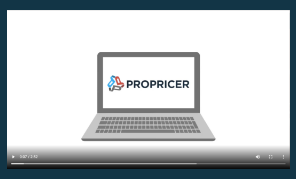It’s easy for small businesses to feel disadvantaged, especially when competing against the big guys for government contracts. And nearly 40% of the respondents in a recent Pricing Magazine survey agreed there should be more resources available exclusively to SMBs. So how can your business gain an edge? One strategy is to make the most of federal contracting programs that help level the playing field.
Federal contracting programs designed to benefit small businesses can offer a mix of resources including funding or set-aside opportunities. From the Small Business Set-Aside Program to R&D funding programs to SBA initiatives—here are the most important federal programs that can give your business an extra advantage:
Small Business Set-Aside Program
The Small Business Set-Aside Program (SBSA) is one of the oldest, most well-known programs designed to help small businesses win government contracts. Federal law requires that 23% of all federal contracting dollars go towards small businesses—and the SBSA helps ensure this goal is met.
The SBSA reserves, or “sets-aside” certain government purchases exclusively for qualifying small businesses. This gives smaller firms a distinct advantage throughout the bidding process and helps guarantee they receive a fair proportion of government contracts. (1)
In order to be awarded a set-aside contract, your business must perform a required percentage of the contract. For construction contracts, the minimum is 15%, while manufacturing and services contracts require as much as 50% of the work to be done by you as the prime.
Some specifics:
- Contracts between $2,500-$100,000: The SBSA’s Set-Aside Program dictates that every contract with an anticipated dollar value within this range be automatically reserved for small businesses. That said, there needs to be a reasonable expectation that offers will be obtained from at least two small businesses that can realistically deliver at fair market prices. This is known as the “Rule of Two,” and if it’s not met, the Contracting Officer is required to make an award to the sole firm that submits.
- Contracts over $100,000: Contracting Officers are also required to set aside any contract over $100,000 for small businesses so long as there is a reasonable expectation that the “Rule of Two” will be met.
- Partial Set-Asides: When a complete set-aside isn’t a viable option, Contracting Officers must set aside a portion of a contract, except for construction, for small business participation. Learn more about partnering up with other players to secure government contracts. (1)
Very Small Business Pilot Program
Another top set-aside program is the Very Small Business (VSB) Pilot Program. This initiative is open to businesses with no more than 15 employees and fewer than $1 million in average annual receipts. Qualifying businesses must also maintain headquarters within one of 10 designated SBA districts.
The VSB program has Contracting Officers set aside contracts that have an anticipated value of between $2,500 to $50,000, specifically for very small businesses.
Although both are authorized by the SBA, the VSB program is distinct from the 8(a) Program - which is geared towards small, disadvantaged firms. Keep in mind the VSB program doesn’t apply to contracts awarded through the 8(a) Program.
Small business R&D funding programs
The Small Business Innovation Research (SBIR) Program and the Small Business Technical Transfer (STTR) Program are designed to encourage research and development for technological and scientific innovations that show potential for commercialization.
These programs help businesses operating within technology, biology, medical, engineering, or other related fields access the resources they need to turn ideas into reality and compete on the same scale as larger corporations.
Qualifying businesses will need to meet several requirements. For starters, they must be small (no more than 500 employees), for-profit, American-owned, independently operated, and the principal researcher must be employed by the business.
Here’s how the two programs compare.
Small Business Innovation Research (SBIR) program
The SBIR program is aimed at small businesses developing technology with significant commercialization potential. Entrepreneurs can access financing for research and development as well as commercialization opportunities.
The SBIR has three distinct phases. Phase I emphasizes “proof of concept” and tests the scientific, technical, and commercial feasibility of a project. It’s up to a six-month period and features an award of $50,000 to $100,000.
If the company is successful in Phase I, they may be invited to apply for Phase II where they will further develop their prototype and have a chance to secure $500,000 to $750,000. After Phase II is completed, firms will need to turn to the private sector for further financing—which constitutes Phase III.
Small Business Technical Transfer (STTR) Program
Both SBIR and the STTR programs share a similar structure. However, the main difference is that the STTR requires small businesses to actively collaborate with non-profit research institutions—such as a university or research institution.
By encouraging collaboration, the STTR hopes to minimize the gap between scientific innovations and private sector commercialization.
The STTR program also has three phases. Phase I centers around the feasibility of a particular project, with awards up to one year and up to $100,000. Phase II further expands on the results of Phase I, with awards up to two years and up to $500,000. Phase III centers around breaking into the marketplace and securing private funding.
Department of Defense SBIR/STTR Fast Track
Businesses accepted into SBIR and STTR programs administered by the Department of Defense may be able to opt into the Fast Track program. This special program features a host of significant advantages you won’t want to ignore.
For starters, the Fast Track program offers a remarkably higher chance of funding awards and can also help businesses secure financing from outside investors.
In order to apply, you’ll have to submit a Fast Track application with the Department of Defense towards the end of your Phase I SBIR or STTR project. (1)
Community Navigator Pilot Program
The SBA’s Community Navigator Pilot Program provides resources to small businesses within underserved communities. The program uses local hubs to foster a connection between local entrepreneurs and the SBA’s resource partners.
Support incorporates financial assistance, contracting opportunities, business development tools, industry-specific training, and more. (2)
Try our free platform: ProPricer Essentials
Government contracting programs can help you get your foot in the door, but it’s ultimately up to you to win the deal. You’ll want to have all the best tools at your disposal—and that includes ProPricer Essentials. It’s the free platform that helps you seamlessly create professional, government proposals in the correct format.
You can generate pricing models as well as basic reports. You can also conduct what-if analyses on numerous scenarios. There’s no better, easier way to create automated proposals that are fully compliant with Federal Acquisition Regulation (FAR), DFARS, Cost Accounting Standards (CAS), and customer requirements. And Essentials is a great steppingstone to ProPricer Contractor Edition. Learn more about ProPricer Essentials here.
Sources
- Wolters Kluwer Article: Small Business Government Contracting Initiatives Can Give You an Edge
- SBA Launches Community Navigator Pilot Program





